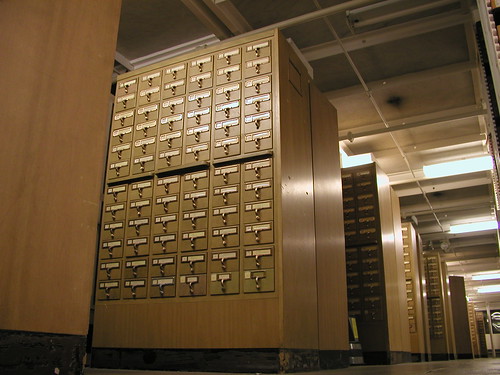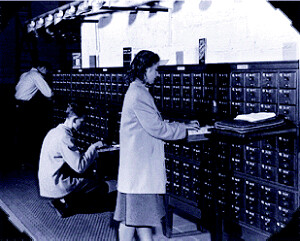
Photo by dfulmer's photostream
I found this exercise to be very beneficial in helping me to understand MARC records in general. I think I could actually read a MARC record and be able to decode most of it now! When I first began trying to decipher MARC records I didn’t think that would ever happen! It all seemed so confusing! There are still some codes that I don’t fully understand but they don’t seem to be the important ones (if that is fair to say). I really do feel quite confident that I understand the most important descriptors now. There were some things that puzzled me such as when to use commas, colons, and semi-colons and other little things and I have gone into more detail below about all of that for anyone who cares for further reading. But overall, I think my level of understanding will more than suffice as a TL in a library so I am ok with that! As time consuming as it was it actually became rather interesting. Having said that, I don’t think I foresee any recreational MARC reading in my future! The experience of actually creating a MARC record however was more daunting and even more time consuming. I learned a lot from having to do it though. I can see however, that assignment two is going to be an incredibly time consuming task. Perhaps out of all the assignments I have done in all of my courses, assignment two will be the assignment that will give me the biggest sense of satisfaction in having completed it! More details about the creation of my MARC record can be found at the end of this reflection.
Tale of Despereaux – Kate DiCamillo
In tag 20 I noticed that there are 4 ISBN numbers for this one book. At first I didn’t understand why but then began to realize that it lists different versions of copies that they have in their system such as hard cover, paperback, library binding, eBook etc. Tag 40 (Cataloguing source) is listed but I can’t see where on this resource (or any of the others) where this information is located. Tag 260 has two cc’s before the date instead of one. I wonder why that is. Also, instead of a colon it is separated by a comma. I wonder when do you use a colon and when do you use a comma? In tag 300 I am wondering why the illustration is separated by a colon and the size is separated by a semi-colon. I also noticed that in tag 650 the subject codes are marked exactly as listed in the Library of Congress Document except that it says juvenile fiction rather than fiction. If it just says fiction in the book shouldn’t it be listed in the same way?
In Grandpa’s House by Philip Sendak
I notice that this record has included not only the ISBN but the price as well which is indicated by $c and then the price. The tag is repeated again this time listing the ISBN and cost of the copy that has Library Binding. I am surprised to see that this can be done. I would have thought that each volume would require a separate MARC record but it appears that they can have one MARC record for more than one volume. I see that for the Main Entry the author’s name and date of birth and death are included. In the title statement I see that the title is listed and then the primary author followed by the information about the translator and illustrator. I notice that for tag 260 there is a 0 in indicator 1 and I am not sure why. Also before the date there are two c’s in the subfield instead of one. Again, I am not sure why. I see that the translation is noted in tag 500 (general note). I notice that tag 651 has an indicator of 1 so that tells me that the subjects come from the Library of Congress Subject Headings. I notice that in tag 700 (Personal Name) that 1 is used for the first indicator but 0 is used for the second when indicating the translators name. The 0 tells me that this record was probably made using standards prior to 1994 because 0 is no longer an indicator used according to our reading.
Ooh-La-La (Max in Love) by Maira Kalman
This resource provided me with a good example of how a title is entered exactly as it appears. In this title there are hyphens as well as brackets and those are included in the MARC records. This is good for me to know. From looking at the tag 650 (Subject-Topical Term) I was able to deduce that there is the need for form subdivision. In this example the topic was dogs and then further classified as juvenile fiction in a subfield, ie., 650 $aDogs$vJuvenile fiction$. This resource also allowed me to see how the subject – geographic name can be used as well. In this example the geographic name was Paris, France again further classified in the subfield of form division juvenile fiction. This resource also illustrated the use of tag 740 - Added entry – uncontrolled related/analytical title. In this case the extra information was the part of the title that was in brackets (Max in Love).
Schools That Learn: A Fifth Discipline Fieldbook for Educators, Parents, and Everyone Who Cares About Education by Peter Senge, et al.
I was surprised to find in this MARC record that in the tag 245 (Title Statement) subfield c (Statement of Responsibility) that only one of the authors was listed and et al was used for all of the others. Nowhere in the MARK record does it list the other author’s names. That is very surprising as I would have thought a MARC record would need to show all of the authors names to be complete. I notice in tag 500 (notes) it lists that it is a fifth discipline resource. I can see that this is a place to add extra details that are pertinent to the resource.
Maus: A Survivors Tale by Art Spiegelman
I noticed in this record that winner of the Pulitzer prize was listed in tag 500 (general note). I also note that tag 505 has the words “and here the troubles began” and at first I didn’t understand why because I didn’t see anywhere on the photocopied resource where these words were appearing on the cover. After I turned the page I realized that it was another volume in the series and so I understood why it was there.
MARC Records observations
When I entered the ISBN number I included 4 numbers but I notice our library record only contains the two RLB versions which I assume mean library bound copies. I noticed that in tag 245 (Title Statement) I accidentally added some extra parts of the title when I should have only added the author’s name. The extra words on the title should have been included in tag 500 (General Note). Also in tag 260 (Publication, distribution) when I entered where the resource was published I had entered the Canadian address while the public library entered the American address. Both addresses where given in the book so I assumed using the Canadian one was the correct one. I wonder why they used the American one? I noticed that the public library also used tag 440 (Series Statement) while I didn’t because the reading we are using says that it is now obsolete. For the most part my MARC record was very similar to the one from the library. The biggest exception was that I used a lot of spaces while the library uses commas and puts things in one line. I also used ## while the library used only spaces.
So from all of this really my only questions are 1) after the tag number do I place number signs (##) or just spaces when there is no indicator number (as our reading suggests)
2) do I put information all in one line or one under the other?
Ie
300 ##$a 32 p. :$b col. ill. ;$c 25 cm.
Or
300 ## $a 32 p. :
$b col. ill. ;
$c 25 cm.






